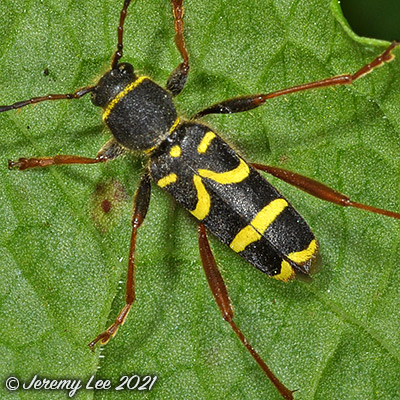
 |
|
Scientific Classifications explained » Amphibians » Ants » Aphids » Bees » Beetles » Birds » Bugs » Butterflies » Caterpillars » Damselflies » Dragonflies » Earwigs » Flies » Frog/Leafhoppers » Fungi » Galls » Grasshoppers » Harvestmen » Hoverflies » Lacewings » Ladybirds » Leaf Mines » Lichens » Mammals » Millipedes » Mosses » Moths » Sawflies » Slugs » Snails » Spiders » Trees & Shrubs » Wasps » Wild Flowers » Woodlice » Postboxes |
UK Nature > Beetles > Clytus arietis

Scientific Name: Clytus arietis Common Name: Wasp Beetle Clytus arietis, as its common name suggests, is a wasp-mimicking longhorn beetle, displaying a combination of yellow stripes on a dark background and a habit of scuttling across foliage in stops and starts like a wasp. To us humans it doesn't look that good an impression, but it is sufficient to discourage many predators in the invertebrate world. In summer the adults can often be seen feeding on the open flowers of cow parsley and hogweed, or running over dead wood in search of a mate or site to lay eggs. The larvae live within freshly dead deciduous trees, feeding on the wood for at least two years. Measuring between 10 - 18mm in length, it is common throughout most of the UK and can be a frequent garden visitor in the south, especially if there are good resources of deadwood nearby. It is less frequent and more local in the north. |
|

https://www.uknature.co.uk is a website dedicated to showing the immense diversity of UK nature and wildlife. Our vast range of habitats, from lowland arable to snow covered mountains, from storm-ravaged coastlines to peaceful inland freshwater lakes and rivers, from dry, sandy heaths to deciduous and coniferous forests, all these habitats contribute to the abundance of UK nature. We have wild birds in huge numbers either residing or visiting our shores (597 recorded species as at July 2013) and we must also not forget the humble back garden with its grass lawns, flower beds filled with nectar rich flowers, shrubs and trees, all designed to attract huge numbers of insects such as bees, moths, butterflies and hoverflies; and finally the small ponds which provide safe havens for frogs, toads, newts and even slow worms and grass snakes. www.uknature.co.uk is the showcase for my personal passion, photographing uknature in all its glory. I sincerely hope you all enjoy the fruits of my labours. This site and all images contained therein is © Jeremy Lee 2004 - 2025. All Rights Reserved. Site design by Jeremy Lee. Site development & IT Support by Stuart Lee. |